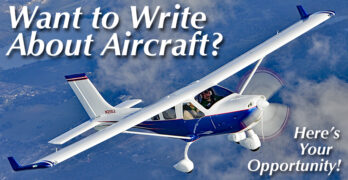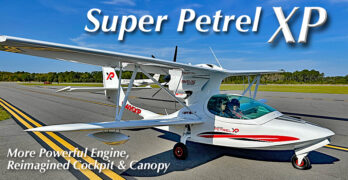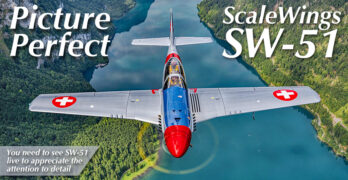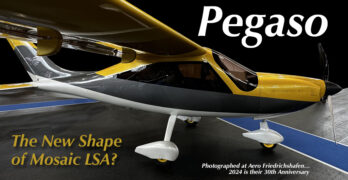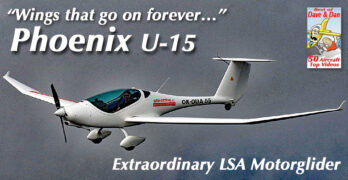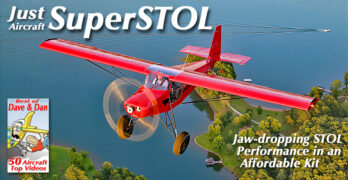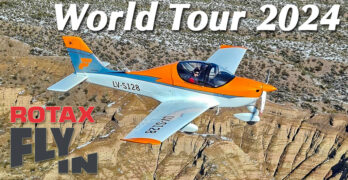Harley Davidson or Rotax — Sounds can be unique and associated with a certain brand. Harley motorcycles have made their sound a trademark, defending it vigorously against wannabe knock-offs.
Sling Pilot Academy found Rotax 912iS engines output a particular sound, too. However, they wanted to shield their neighbors from it. As busy as Sling Pilot Academy has become, keeping good relations is essential.
So, Whisper Sling
Necessity is the mother of invention, so the saying goes. Necessity, in this case, was success.
(SPA) at the Torrance, California, airport has grown to become a training behemoth, with their fleet flying more than 4,000 hours per month, the bulk of it in the Sling two-place LSA it uses as a primary trainer. That makes the SPA one of the busiest training companies in the region.
And Torrance, like many urban airports, faces increasing complaints from non-pilot neighbors; in fact, Torrance’s very existence has been threatened for decades by those opposed to the presence of airplanes at, get this, an airport.
Search Results for :
Not finding exactly what you expected? Try our advanced search option.
Select a manufacturer to go straight to all our content about that manufacturer.
Select an aircraft model to go straight to all our content about that model.
Do You Love LSA and Sport Pilot Kits? Calling for Writers in the Affordable Space
By the middle of March, this website had exceeded all prior monthly records. In only 16 days, we recorded an all-time high in single-day non-repeating visitor count and in monthly visitors.
So, it is already certain that I will conclude my full-time activities with ByDanJohnson.com on a very high note and I am grateful beyond what I can convey. I had hoped to “go out at the top of my game” and this strong response from visitors is a wonderful send-off.
Please believe me, though, the genuine thanks are from me to you, not the other way around.
I am deeply appreciative of your loyal readership for these past 20 years. Thank you from the bottom of my pilot’s heart.
Is Affordable Aviation
Really a Thing?
I didn’t know I was creating the affordable aviation space when I began my online adventure back in 1999 — it took four years of work in those early days of the World Wide Web but we went live on April 1, 2004.
Super Petrel XP Arrives in Florida; Proven Product Significantly Upgraded
A few days ago a couple Super Petrel XPs arrived in Florida. In no time, Roger Helton‘s team had the pair assembled and had earned their Special Airworthiness Certificates, from two different FAA inspectors no less.
Development happens fast in light aviation; Mosaic will further quicken the pace.
Welcome to Light-Sport Aircraft where the swift thrive and those that can’t move fast enough fall behind. LSA is a market full of seasoned competitors. They’ve learned their trade well, surviving and some even gaining during the Covid upset. Any new creation coming to market will be measured against tough standards.
You think the pace of development is fast now? Wait as Mosaic approaches and company after company announces new products to take advantage of the “Christmas in July” list of new privileges FAA offered in the summer release of their Mosaic proposal (view list at bottom). The regulation is currently in review by the agency and according to their own statements, it should go live by second quarter 2025 (2Q25).
Your Own P-51? (Only Modern?) — Remarkable SW-51 Increases Production
Every pilot loves a P-51 Mustang, right? The World War II fighter with gutsy lines and a thundering engine turning a giant prop consistently ranks as one of the most desirable airplanes of all time.
Don’t even think about affording a real P-51 unless you win the lottery. Warbirds may be the biggest attraction at AirVenture Oshkosh year after year but only a few pilots have sufficiently deep pockets to own and fly one of these historic machines.
SW-51 is breathtakingly priced as well, many readers may think. Nonetheless, SW-51 is an awesome-looking flying machine that some will figure out how to afford.
Even more rare than a Ferrari, SW-51 is a very-limited-production design. The company forecasts a dozen aircraft per year. At that rate and given SW-51’s exquisite detail, I’ll bet they can sell out year after year.
Mount Your Mustang
You can watch a video below from Sun ‘n Fun 2022 that provides additional and fairly recent detail.
The Shape of Tomorrow? Pegaso Is Another Beautiful Light-Sport Airplane You’ve Never Seen
Pilots who have attended the Aero Friedrichshafen show in Germany may have spotted Pegaso since it first exhibited in 2018. Six years later, the model lacks American representation so Yankee pilots generally don’t know this flying machine.
This is Pegaso, a European “ultralight” that expresses a beautiful style we expect from Italy.
Promecc is better known for their low-wing Sparviero but Pegaso drew lots of admiring looks at Aero 2023.
Let’s take a deeper look at an aircraft that can help imagine what we’ll see as Mosaic emerges from FAA rule making in the second quarter of 2025.
Promecc Pegaso
Promecc Aerospace specializes in the design and manufacture of European-style ultralight aircraft predominantly using carbon fiber construction. As is more common in Europe, the company behind Pegaso and Sparviero has a larger operation involved in professional aviation.
The company’s first design, Sparviero, which translates to Sparrowhawk in English, was introduced in the early 2000s.
Upping the Ante Pre-Mosaic — Icon Bumps Useful Load of A5 LSA Seaplane
Mosaic is coming! Are you ready?
OK, Mosaic is still around 15 months away (based on FAA’s often-repeated statement). But good companies plan ahead for changes they can foresee. Icon is moving to increase capabilities on their A5 LSA seaplane… plus, the company is responding to customers who gave feedback to the California aircraft manufacturer.
As most readers now know, Mosaic LSA can be larger and therefore they can carry more. While these airplanes remain more than a year from first deliveries current LSA models are expanding their capacities in preparation.
Go Bigger!
Icon Aircraft released news about the 2024 A5. “After nearly two years of rigorous R&D, testing, and production preparation, Icon is excited to announce that it has increased the gross weight of the A5 by 60 pounds, resulting in a new useful load of 490 pounds (up from 430 pounds),” the company stated.
This change comes from a gross weight increase to 1,570 pounds.
News Bits — Sun ‘n Fun 50th Birthday, Hexa Draws Big Media to Lakeland, VREF & LSA
To start off your new workweek, here are fresh light aviation news bits from last week.
Not all aviation news items justify a whole article but that doesn’t mean these accomplishments should be ignored. Here are three such items. Each exerts an influence on the future of flying.
Let’s get the newsday started…
Whoo Hoo!
Sun ‘n Fun Turns 50!
Keen to celebrate their 50th anniversary, Sun ‘n Fun sent out a special invitation that may be of great interest to fly-in campers.
Sun ‘n Fun e-blasted, “6 Things To Do When You Land at Sun ‘n Fun 2024!” The half-century-old event runs April 9 to 14, 2024 in Lakeland, Florida.
After you park your airplane and find your camping spot for the week, head on over to The Island.
Check in at the Pilot Welcome Center brought to you by Phillips 66.
Visit the Island Country Store and stock up on your basic necessities.
Flight of the Phoenix (Motorglider) — Top 50 Video Star Is Back with News
The Top 50 video series has gone over very well and continues with this post about the Phoenix LSA motorglider. If you thought it disappeared and were unhappy about that, have I got good news for you!
I am aware of a very positive development regarding Phoenix that I am working to confirm. As soon as I have fuller details I will update this article but the prospects for LSA motorglider look promising.
In North America, Phoenix Air USA is run by Ed Babovec (email) and he is excited about 2024. …more as it unfolds.
Motorgliders as a subset of all aircraft enjoy some very special privileges that endear them to the recreational flying community. In particular, motorgliders do not require an aviation medical. That alone makes them desirable but long-gliding capabilities make them safer to some pilots and simply more enjoyable to others. Let’s look a little more deeply.
Top 50: Just Aircraft Escapade > Highlander > SuperSTOL and More…
Here we go again… in a great way, I hope. Returning to our Top 50 Video series, we come to Just Aircraft and their jaw-dropping SuperSTOL. At airshows in recent years, lots of pilots spoke with excitement about STOL competitions. Just’s SuperSTOL was often part of the conversation.
Videos highlighted in our Top 50 series are the most popular 50 selections from a library of about 1,000 videos appearing on Dave Loveman’s Light Sport and Ultralight Flyer YouTube channel. They represent the “Best of Dave & Dan” videos as determined by your views.
Just Aircraft has a long history of building close to 1,000 aircraft, the company said in early 2024. A large share of these, around 800, were SuperSTOL kits. The lines are a bit indistinct because SuperSTOL is at heart a Highlander kit hopped up on steroids (or the airplane equivalent). These days, Highlander remains a good seller for Walhalla, South Carolina-based Just Aircraft, said main man Gary Schmitt on a recent phone call.
Rotax Aircraft Engines Fly-In World Tour 2024 — Dates Announced for Global Series
For some years, Rotax Aircraft Engines has invited their worldwide flock to Wels, Austria. This charming town north of Salzburg is near the home of Rotax’s headquarters in Gunskirken.
On three separate visits to Rotax I was able to attend one of their Fly-in events plus a special visit just for aviation journalists.
Beautiful and inviting as Wels is, this is not an easy visit for folks from the company’s far-flung customer base in nearly every country on Earth. So, in addition to inviting the world to their headquarters event, Rotax is going abroad.
Get ready for Rotax’s World Tour 2024!
The Biggest goes Bigger
BRP-Rotax is the Austrian subsidiary of BRP Inc, “a leader in the development and production of propulsion systems for the recreational and powersports markets,” according to the company.
Founded in 1920, BRP-Rotax builds innovative Rotax four-stroke and two-stroke high-performance engines used in products such as Ski-Doo and Lynx snowmobiles, Sea-Doo personal watercraft, Can-Am onroad and offroad vehicles, as well as for karts and sport planes.
- « Previous Page
- 1
- 2
- 3
- 4
- 5
- …
- 309
- Next Page »



